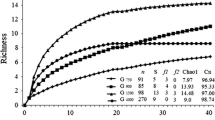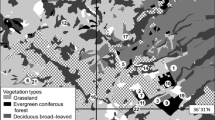Summary
Carabid beetles were sampled in 1980 and 1981 by pitfall trapping in two biologically and two conventionally farmed potato fields in B. Zell, Upper Austria. The cultivation differences consisted mainly of a herbicide application to one conventional field in 1980 and higher fertilization levels in both conventional fields in both years. The total carabid catch was 7428 beetles, representing 48 species. In both years the numbers of total carabids and numbers of species were higher in the biologically farmed fields. Of 16 dominant species (representing 96% of all carabids) only 5 (e.g., Platynus dorsalis, Poecilus cupreus) showed similar activity densities under both types of cultivation. Five species (e.g., Carabus spp., Amara consularis, Harpalus rufipes) were frequent only in one field. Pterostichus melanarius was the only species more numerous in the conventional fields, whereas five species occurred either more frequently or exclusively in the biological fields. Of these five species, Poecilus versicolor, Dyschirius globosus, Calathus fuscipes and, only regionally, Harpalus aeneus are considered to be bioindicators for biologically farmed agroecosystems. The frequencies of Amara consularis and Harpalus rufipes are apparently related to weed vegetation.
Similar content being viewed by others
References
Ammer U, Utschick H, Anton H (1988) Die Auswirkungen von biologischem und konventionellem Landbau auf Flora und Fauna. Forstwissen Centralbl. 107:274–291
Andersen J (1987) Qualitative changes in the Norwegian carabid beetle fauna during the present century. Acta Phytopathol Entomol Hung 22:35–44
Baars MA (1979) Catches in pitfall traps in relation to mean densities of carabid beetles. Oecologia 41: 25–46
Basedow T (1973) Der Einfluß epigäischer Raubarthropoden auf die Abundanz phytophager Insekten in der Agrarlandschaft Pedobiologia 13:410–422
Basedow T (1987) Der Einfluß gesteigerter Bewirtschaftungsintensität im Getreidebau auf die Laufkäfer (Coleoptera, Carabidae). Mitt Biol Bundesanst Land- Forstwirtsch Berlin-Dahlem 235
Basedow T, Rzehak H (1988) Abundanz und Aktivitätsdichte epigäischer Raubarthropoden auf Ackerflächen — ein Vergleich. Zool Jahrb Syst 115:495–508
Basedow T, Borg A, De Clercq R, Nijveldt W, Scherney F (1976) Untersuchungen über das Vorkommen der Laufkäfer (Col.: Carabidae) auf europäischen Getreidefeldern. Entomophaga 21:59–72
Bick H (1982) Bioindikatoren und Umweltschutz. Decheniana Beih 26:2–5
Bosch J (1987) Der Einfluß einiger dominanter Ackerunkräuter auf Nutz- und Schadarthropoden in einem Zuckerrübenfeld. Z Pflanzenkr Pflanzenschutz 94:398–408
Bousquet Y, Smetana A, Maddison DR (1984) Trechus quadristriatus: A palaearctic species introduced into North America (Col. Carabidae). Can Entomol 116:215–220
Croy P (1987) Faunistisch-ökologische Untersuchungen der Carabiden im Umfeld eines industriellen Ballungsgebietes. Entomol Nachr (Berlin) 31:1–9
Diercks R (1983) Alternativen im Landbau. Ulmer Verlag, Stuttgart, pp 28–44
Dritschilo W, Wanner D (1980) Ground beetle abundance in organic and conventional corn fields. Environ Entomol 9:629–631
Foissner W, Franz H, Adam H (1987) Untersuchungen über das Bodenleben in ökologisch und konventionell bewirtschafteten Acker- und Grünlandböden im Raum Salzburg. Verh Ges Ökol 15:333–339
Freitag R (1979) Carabid beetles and pollution. In: Halpern AL (ed) Carabid beetles: their evolution, natural history and classification. Junk, The Hague Boston London, pp 507–521
Freude H (1976) Adephaga 1. In: Freude H, Harde KW, Lohse GA (eds) Die Käfer Mitteleuropas. Bd 2. Goecke Evers, Krefeld
Gärtner G (1980) Ökologisch-faunistische Veränderungen durch Flurbereinigungsmaßnahmen. Dargestellt am Beispiel der Carabidenfauna von Zuckerrübenkulturen in ausgewählten Kraichgaugemeinden. PhD dissertation, University of Heidelberg, FRG
Gersdorf E (1937) Ökologisch-faunistische Untersuchungen über die Carabiden der mecklenburgischen Landschaft. Zool Jahrb Syst 70:17–86
Hance T, Gregoire-Wibo C (1987) Effect of agricultural practices on carabid populations. Acta Phytopathol Entomol Hung 22:147–160
Hempel W, Hiebsch H, Schiemenz H (1971) Zum Einfluß der Weidewirtschaft auf die Arthropoden-Fauna im Mittelgebirge. Faun Abh Mus Tierkde, Dresden 3:235–281
Heydemann B (1953) Agrarökologische Problematik (dargetan an Untersuchungen über die Tierwelt der Bodenoberfläche der Kulturfelder). PhD dissertation, University of Kiel, FRG
Heydemann B (1955) Carabiden der Kulturfelder als ökologische Indikatoren. Ber 7. Wandervers dt Entomologen, pp 172–185
Heydemann B, Meyer H (1983) Auswirkungen der Intensivkultur auf die Fauna in den Agrabiotopen. Deutscher Rat für Landespflege und Landwirtschaft 42:174–191
Hokkanen H, Holopainen JK (1986) Carabid species and activity densities in biologically and conventionally managed cabbage fields. J Appl Entomol 102:353–363
Honczarenko J (1975) The effects of high doses of nitrogenous fertilizers on the Insecta of meadow soils. Pedobiologia 16:58–62 (in Russian with English summary)
Hossfeld R (1963) Synökologischer Vergleich der Fauna von Winter-und Sommerrapsfeldern. Z Angew Entomol 52:209–254
Hurlbert SH (1984) Pseudoreplication and the design of ecological field experiments. Ecol Monogr 54:187–211
Ingrisch S, Glück E, Wasner U (1989) Zur Wirkung des biologisch-dynamischen und konventionellen Landbaues auf die oberirdische Fauna des Ackers. Verh Ges Ökol 18:835–841
Kajak A (1981) Analysis of the effect of mineral fertilization on the meadow spider community. Ekol Pol 29:313–326
Kaule G (1986) Arten- und Biotopschutz. Ulmer Verlag, Stuttgart, pp 172–175
Kirchner H (1960) Untersuchungen zur Ökologie feldbewohnender Carabiden. PhD dissertation, University of Köln, FRG
Kleinert J (1987) Changes in the distribution of Carabus cancellatus (Coleoptera: Carabidae) in Slovakia. Acta Phytopathol Entomol Hung 22:161–163
Kokta C (1990) Auswirkungen abgestufter Intensität der Pflanzenproduktion auf Laufkäfer (Carabidae). Mitt Deutsch Ges allg and Entomol 6 (in press)
Kromp B (1985) Zur Laufkäferfauna (Coleoptera, Carabidae) von Äckern in drei Gegenden Österreichs unter besonderer Berücksichtigung der Bewirtschaftungsweise. PhD thesis, Wien
Kromp B (1989) Carabid beetle communities (Carabidae, Coleoptera) in biologically and conventionally farmed agroecosystems. Agric Ecosyst Environ 27:241–251
Loughridge AH, Luff ML (1983) Aphid predation by Harpalus rufipes (De Geer) (Coleoptera-Carabidae) in the laboratory and field. J Appl Ecol 20:451–462
Lövei GL (1984) Ground beetles (Coleoptera: Carabidae) in two types of maize fields in Hungary. Pedobiologia 26:57–64
Luff ML (1980) The biology of the ground beetle Harpalus rufipes in a strawberry field in Northumberland. Ann Appl Biol 94: 153–164
Luff ML, Rushton SP (1989) The ground beetle and spider fauna of managed and unimproved upland pasture. Agric Ecosyst Environ 25:195–205
Mader H-J (1984) Der Einfluß der Intensiv-Bewirtschaftung im Obstbau auf die epigäische Fauna am Beispiel der Laufkäfer und Spinnen. Decheniana 137:105–111
Maurer LJ (1989) An ecological approach to agriculture. The Austrian example. Agric Ecosyst Environ 27:573–578
Moosbeckhofer R (1983) Laboruntersuchungen über den Einfluß einiger Pflanzenschutzmittel auf Ei- und Larvenstadien von Poecilus cupreus L. und Poecilus sericeus Fischer d.W. (Col., Carabidae). Z Angew Entomol 95:513–523
Mühle E (1944) Beobachtungen über das Vorkommen und die Lebensweise von Laufkäfern in Grassamenbeständen und Versuche zu ihrer Bekämpfung. Z Pflanzenkr Pflanzenschutz 54:4–12
Pawlitzki KH (1984) Auswirkungen abgestufter Produktionsintensitäten auf die Aktivitätsabundanz von Feldcarabiden (Coleoptera, Carabidae) sowie auf die Selbstregulation von Agrarökosystemen. Bayer Landwirtsch Jahrb 61, Sondernummer 2:11–41
Porret M (1977) Comparaison d'écosystèmes de prairies permanentes exploitées de manière conventionnelle et biodynamique. Veroeff Geobot Inst Eidg Tech Hochsch Stift Ruebel Zuerich 65
Powell W, Dean DJ, Dewar A (1985) The influence of weeds on polyphagous arthropod predators in winter wheat. Crop Protect 4:298–312
Scherney F (1960) Kartoffelkäferbekämpfung mit Laufkäfern (Gattung Carabus). Pflanzenschutz 12:34–35
Sekulić R, Čamprag D, Kereši T, Taloši B (1987) Fluctuations of carabid population density in winter wheat fields in the region of Bačka, Northeastern Yugoslavia (1961–1965). Acta Phytopathol Entomol Hung 22:265–271
Stachow U (1987) Aktivitäten von Laufkäfern (Carabidae, Col.) in einem intensiv wirtschaftenden Ackerbaubetrieb unter Berücksichtigung des Einflusses von Wallhecken. Schriftenr Inst Wasserwirtsch Landschaftsökol Kiel 5
Sunderland KD, Chambers RJ, Stacey DL, Crook NE (1985) Invertebrate polyphagous predators and cereal aphids. Bull SROP/WPRS VIII/3:105–114
Thiele HU (1977) Carabid beetles in their environments. Zoophysiology and ecology 10. Springer, Berlin Heidelberg New York
Tietze F (1985) Veränderungen der Arten- und Dominanzstruktur in Laufkäfertaxozönosen (Coleoptera-Carabidae) bewirtschafteter Graslandökosysteme durch Intensivierungsfaktoren. Zool Jahrb Syst 112:367–382
Tischler W (1958) Synökologische Untersuchungen an der Fauna der Felder und Feldgehölze (ein Beitrag zur Ökologie der Kulturland-schaft). Z Morphol Oekol Tiere 47:54–114
Van Dijk TS (1986) Changes in the carabid fauna of a previously agricultural field during the first twelve years of impoverishing treatments. Neth J Zool 36:413–437
Weber G (1983) Die Carabidenfauna intensiv bewirtschafteter Felder des Versuchsguts Dikopshof. PhD dissertation, University of Bonn, FRG
Author information
Authors and Affiliations
Additional information
Dedicated to the late Prof. Dr. W. Kühnelt
Rights and permissions
About this article
Cite this article
Kromp, B. Carabid beetles (Coleoptera, Carabidae) as bioindicators in biological and conventional farming in Austrian potato fields. Biol Fertil Soils 9, 182–187 (1990). https://doi.org/10.1007/BF00335805
Received:
Issue Date:
DOI: https://doi.org/10.1007/BF00335805




